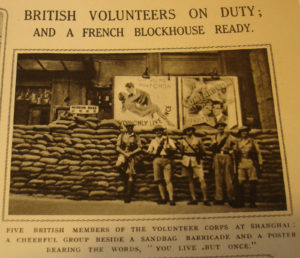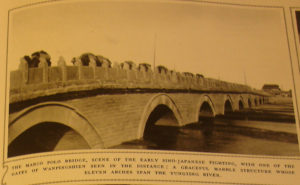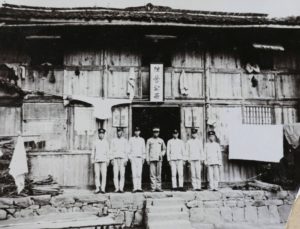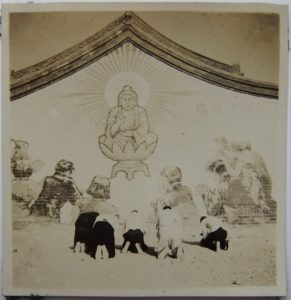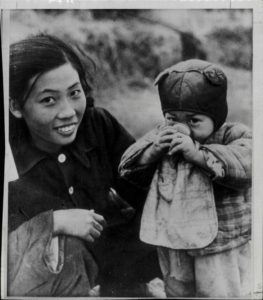Laura Putnam has an article out in the new issue of AHR “The Transnational and the Text-Searchable: Digitized Sources and the Shadows They Cast“
One of her points is the modern, digitally searchable sources make it easier to do transnational history. It used to be that doing transnational history meant going to several archives and learning several sets of sources. That’s why so few people did it. Putnam is of course not opposed to the new “drive-by transnationalism,” but she does want to point out some of the problems it creates. Scholars in the global south, or at smaller schools, can’t really participate. More importantly, you loose a lot of the context for the sources you are looking at. It is easier to collect sources that you don’t really understand when all you need to do to find them is push a button.
I of course agree with this, and I would expand on the problems a little. Digitization really does encourage the use of the type of sources that are likely to be digitized and made available. Newspapers are a good example. Many years ago Lloyd Eastman claimed that the China field should be getting beyond the point where finding the references to an event in the major Shanghai papers counted as good research, but we are sort of moving back that way. Of course there is nothing wrong with that, or rather there are some good things about making it easy to find out what Shibao said about something. This is just a new version of of the old fact that historians use sources that are easy to find. Putnam even quotes E.H. Carr about historians and fish.1
Most of what Putnam is talking about are the cooked digital sources. Things like digitized newspapers and archives, where someone has done the work to figure out was this is, classify it, and make it cite-able. Some of these are lightly cooked sources, like a digitized archive, where you are just looking at the same thing you could see on paper, only on a screen. Some are cooked a bit more, like newspaper archives, where they may have done OCR to make things searchable, and even added keywords, but is still the same stuff you could have found the old fashioned way.
What about the raw sources? The things that you can find with a google search that don’t turn up in libraries or archives? As an undergraduate my professors never had to spend time explaining to me how to assess sources I could not find in our library, since I was not going to find anything like that. Undergraduates actually make a good example of how things have changed. As an undergrad, I always liked books. Easy to find under topic headings in the card catalog, or even by shelf reading. Journal articles meant looking for bibliographies or indexes or something. Now JSTOR is step one for undergraduate research. Well, maybe step two. Now people find all sorts of things out in the wild. This is sometimes true of texts with things like Google books and Internet Archive, but the best example is pictures. Google Image search will find you lots of things, but what are they? Nowadays even modern historians are becoming like archaeologists sorting through a bunch of Victorian loot. It’s cool stuff, and you really want to use it, but there is no chain of custody. What is this stuff?
My example here is China Postcard, who I have posted about before. I have no idea who China Postcard is, but they have a Flickr account where they post…all sorts of China pictures. I mostly use this for teaching. There is all sorts of stuff in here, but it is not always easy to make sense of.2
Here we have foreigners, ready to defend Shanghai in 1937
and posing under a poster for the film “You Only Live Once.” This is obviously a staged shot, in the sense that I am sure they chose to pose under that poster for a reason. More importantly, you can’t really cite it, since it is clearly taken from a book, but they do not tell you which one (although I suspect you could find it.) For teaching purposes this does not much matter. If you need a picture of the Marco Polo Bridge WITH CAMELS…here you go. Well, I think they are camels.
A lot of the stuff here is old press photos, and they are pretty good at including the captions. So here are Chinese female pilots learning something in 1973. If you are working on aviation in China, this is a nice find.
Some of them tell you what they are, but you still can’t make sense of them. Here is a foreigner, walking through a Beijing park in 1967…with a copy of Playboy. 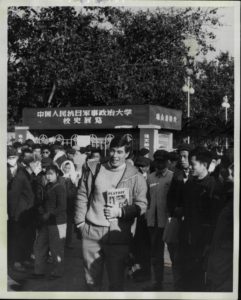
With this even knowing the caption does not help you figure out what is going on.
Most interesting to me, and most relevant to Putnam, are the less sourced things. Here is a photo taken by a British sailor outside the military harbor in Qingdao in the 1930’s. Or at least that’s what China Postcard says.
I assume anyone interested in the cult of Sun or GMD propaganda would find this interesting. Was the Will posted all over China? Just on the borders? Always in both Chinese and English? They might want more information, but place, decade and taken by a British sailor is actually pretty good. Some of them are a lot more vague. These are Chinese police in Shanghai in the 1910’s. Obviously some of the New Policies police reforms have happened, but the physical infrastructure of modern policing is not quite there yet. Cops seem to be a popular topic for both photos and commercial postcards, so someone interested in the New Policies could find a lot of data.
All I have for this is 1930’s, a family shrine, probably in Dongbei.
This is a really interesting photo, and it makes me think of all sorts of questions about popular religion. Is this really a family shrine? It looks public to me. Are some of the painted-on worshippers non-Chinese? Does it say something in the upper right? Is this even a Buddhist shrine, or is it one of the New Religions or something else? Without more context it might be hard to figure out what to make of it, however. China Postcard seems to have gotten it from a blog post, so the trail runs cold.
So, to sum up, you should read the Putnam, because it is good, but there is more to it then that. Digital history not only making it easy for us to find things quickly, even if we don’t know what they are, it is also making it easy to find things that we have no clue what to make of, or even how to date. Modern historians are becoming ancient historians, at least in some ways.
We are like this little guy, fleeing China in 1949, with no clear idea where we are, where we are going, or how to make sense of it all.
Admittedly, most of us are not as cute as he is.
The facts are really not at all like fish on the fishmonger’s slab. They are like fish swimming about in a vast and sometimes inaccessible ocean; and what the historian catches will depend, partly on chance, but mainly on what part of the ocean he chooses to fish in and what tackle he chooses to use – these two factors being, of course, determined by the kind of fish he wants to catch. By and large, the historian will get the kind of facts he wants. History means interpretation. What is History p.23. Why do I include this quote? Well, its a good quote. Also, I found it by googling to wikipedia and thus could drop it in here without having to dig up a copy of Carr and type it in. ↩
It is also not all that well key-worded, so you have to do old fashioned look at everything research. ↩
